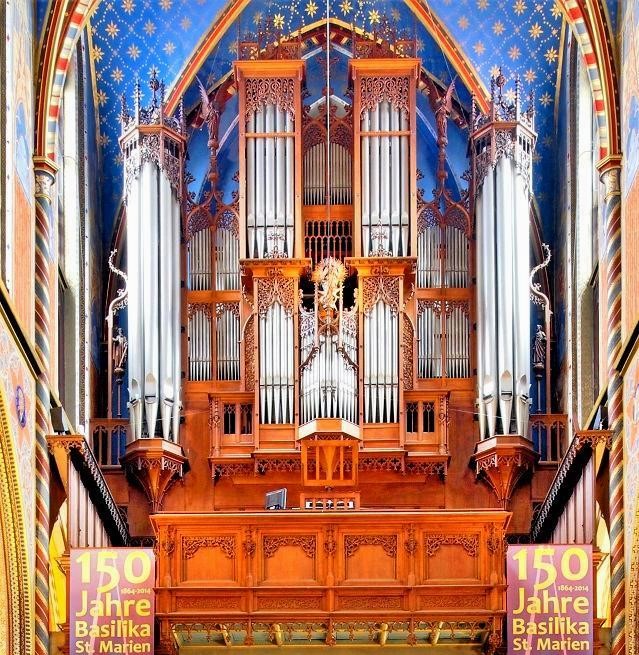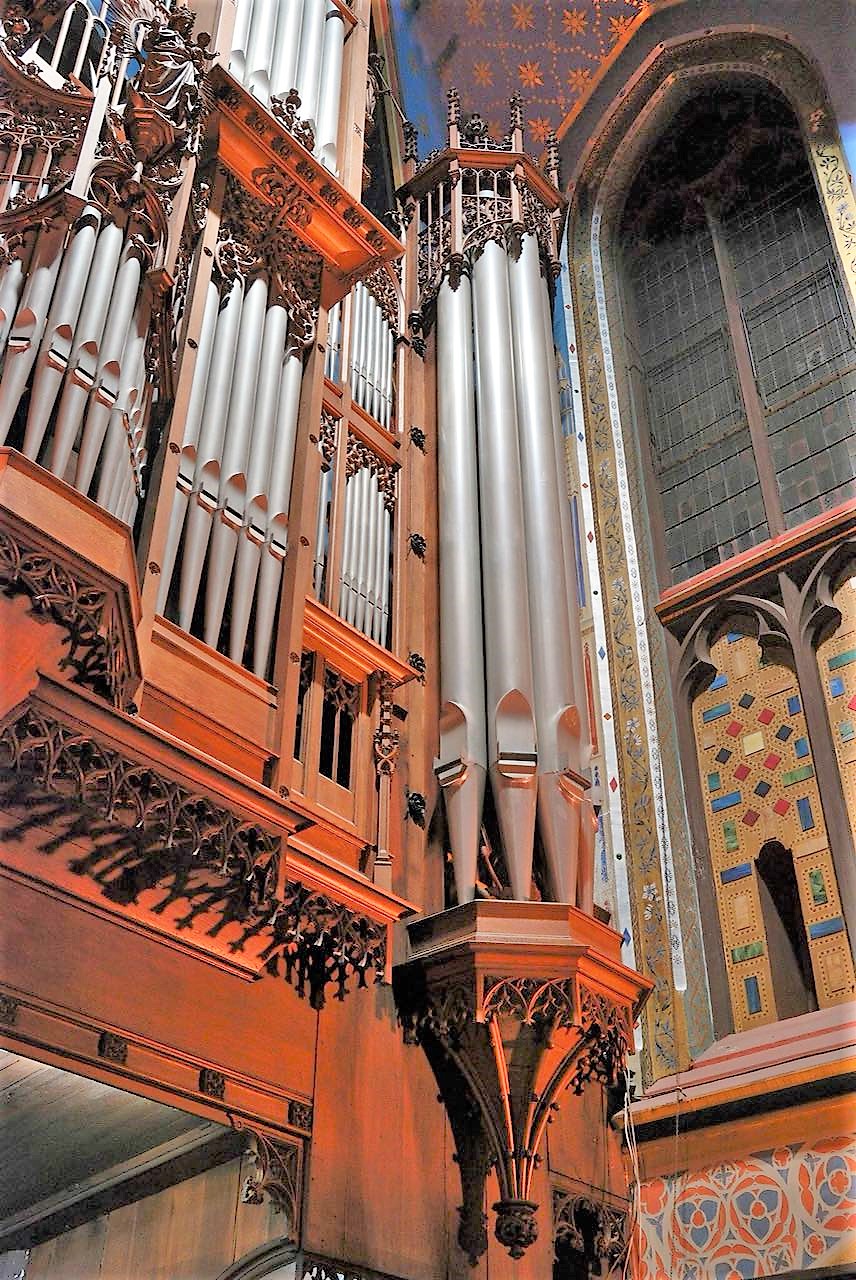Kevelaer Mitte, Marienbasilika (Main Organ)
| Builder | E. Seifert |
|---|---|
| Year | ca. 1907 |
| Period/Style | Romantic |
| Stops | 140 |
| Keyboards | 4+P |
| Keyaction | electro-pneumatic |
The pipe organ was constructed by Ernst Seifert (Cologne and Kevelaer) in 1905-07. Initially, in 1907, it was built with a remote console, the main organ was fully pneumatic, the remote console being electropneumatic, with an additional console.
In 1926, it was expanded to have four manuals (keyboards) and 126 stops, and was converted to electropneumatics. During WWII in 1945, the organ was restored to four manuals with 110 stops after suffering war damage. However, the original neo-Gothic casing was destroyed and later incinerated.
In 1977, reconstruction began and the organ was restored without its remote console; the casing was also reconstructed. Restoration was concluded in 1982 with the addition of a subwork of 13 registers on electric slider chests, which later became the auxiliary work.
In 1987, for the Pope's visit, it was further expanded with the Bombarden keyboard (Tuba magna 16', Tuba mirabilis 8', Cor harmonique 4'). This was followed by an overhaul and cleaning after a church fire in 2002, and reconstruction of the original console.
In 2004, the remote console which had been destroyed in the war was reconstructed. In 2010, efforts began to restore the organ to its original condition, introducing the first register of Viola 16' in the upperwork as an anniversary gift from Seifert for their 125th company anniversary, and installing the original Euphone 8' in the mainwork which had been removed in 1980.
By 2018, the organ had been fully restored, with the exception a few missing registers and the remote console which was deemed unfit for the original's design. These missing parts were replaced in the years that followed, with complete cleaning in 2022 and introduction of the last missing registers.
The pipe organ is housed in a neo-Gothic swallow's nest, measuring 14m in height, 9m in width, and 10m in depth.
In 1926, it was expanded to have four manuals (keyboards) and 126 stops, and was converted to electropneumatics. During WWII in 1945, the organ was restored to four manuals with 110 stops after suffering war damage. However, the original neo-Gothic casing was destroyed and later incinerated.
In 1977, reconstruction began and the organ was restored without its remote console; the casing was also reconstructed. Restoration was concluded in 1982 with the addition of a subwork of 13 registers on electric slider chests, which later became the auxiliary work.
In 1987, for the Pope's visit, it was further expanded with the Bombarden keyboard (Tuba magna 16', Tuba mirabilis 8', Cor harmonique 4'). This was followed by an overhaul and cleaning after a church fire in 2002, and reconstruction of the original console.
In 2004, the remote console which had been destroyed in the war was reconstructed. In 2010, efforts began to restore the organ to its original condition, introducing the first register of Viola 16' in the upperwork as an anniversary gift from Seifert for their 125th company anniversary, and installing the original Euphone 8' in the mainwork which had been removed in 1980.
By 2018, the organ had been fully restored, with the exception a few missing registers and the remote console which was deemed unfit for the original's design. These missing parts were replaced in the years that followed, with complete cleaning in 2022 and introduction of the last missing registers.
The pipe organ is housed in a neo-Gothic swallow's nest, measuring 14m in height, 9m in width, and 10m in depth.
| I Hauptwerk | II Oberwerk | III Schwellwerk | IV Fernwerk | Pedal |
|---|---|---|---|---|
| Principal 16' | Viola 16' | Salicet 16' | Bordun 16' | Contrabass 32' |
| Bordun 16' | Gedackt 16' | Lieblich Gedackt 16' | Principal 8' | Bordun 32' |
| Gambe 16' | Principal 8' | Principal major 8' | Seraphon Flöte 8' | Principalbass 16' |
| Seraphon Principal 8' | Seraphon Gamba 8' | Geigenprincipal 8' | Gedackt 8' | Octavbass 16' |
| Principal 8' | Seraphon Gedackt 8' | Seraphon Concertflöte 8' | Violine 8' | Violon 16' |
| Seraphon Fugara 8' | Flaut harmonique 8' | Seraphon Violine 8' | Aeoline 8' | Subbass 16' |
| Seraphon Flöte 8' | Rohrflöte 8' | Horn 8' | Vox coelestis 8' | Gedacktbass 16' |
| Flaut major 8' | Cello 8' | Flaut Amabile 8' | Labial Oboe 8' | Salicetbass 16' |
| Gemshorn 8' | Vox Angelica 8' | Salicional 8' | Quintatön 8' | Quintbass 102/3' |
| Gedackt 8' | Dolce 8' | Gedackt 8' | Octave 4' | Principal 8' |
| Gambe 8' | Quintatön 8' | Aeoline 8' | Traversflöte 4' | Cello 8' |
| Violine 8' | Octave 4' | Vox coelestis 8' | Waldflöte 2' | Bassflöte 8' |
| Quinte 51/3' | Rohrflöte 4' | Octave 4' | Sesquialter 2f | Bordun 8' |
| Seraphon Octave 4' | Flauto dolce 4' | Traversflöte 4' | Trompete 8' | Dulciana 8' |
| Seraphon Fugara 4' | Violine 4' | Nachthorn 4' | Cor Anglais 8' | Terzbass 62/5' |
| Octave 4' | Septime 22/7' | Gemshorn 4' | Physharmonika 16' | Quinte 51/3' |
| Hohlflöte 4' | Nasard 22/3' | Cremona 4' | Physharmonika 8' | Septime 44/7' |
| Flauto 4' | Octave 2' | Quintflöte 22/3' | Celesta | Seraphon Fugara 4' |
| Terz 31/5' | Piccolo 2' | Flautino 2' | Tuba magna 16' | Octave 4' |
| Quinte 22/3' | Terz 13/5' | Terzflöte 13/5' | Tuba mirabilis 8' | Flöte 4' |
| Octave 2' | Progressio 3f | Harmonia aetheria 3f | Cor harmonique 4' | Bombarde 32' |
| Flauto 2' | Mixtur 4f | Cornett 5f | Seraphon Celesta | Posaune 16' |
| Octavin 1' | Cornett 5f | Mixtur 5f | Cymbelstern | Trompete 16' |
| Mixtur 5f | Fagott 16' | Carrillon 3f | Trompete 8' | |
| Cymbel 5f | Trompete 8' | Tuba 16' | Fagott 8' | |
| Cornett 2-4f | Clarinette 8' | Trompete 8' | Clairon 4' | |
| Tuba 16' | Schalmei 8' | Oboe 8' | Seraphon Clarino 2' | |
| Trompete 8' | Trompete 4' | Krummhorn 8' | Subbass 16' | |
| Euphone 8' | Vox humana 8' | Gedacktbass 16' | ||
| Clairon 4' | Octavbass 8' |
https://organindex.de/index.php?title=Kevelaer,_Marienbasilika_(Hauptorgel)
 Pipe Organ Map
Pipe Organ Map


